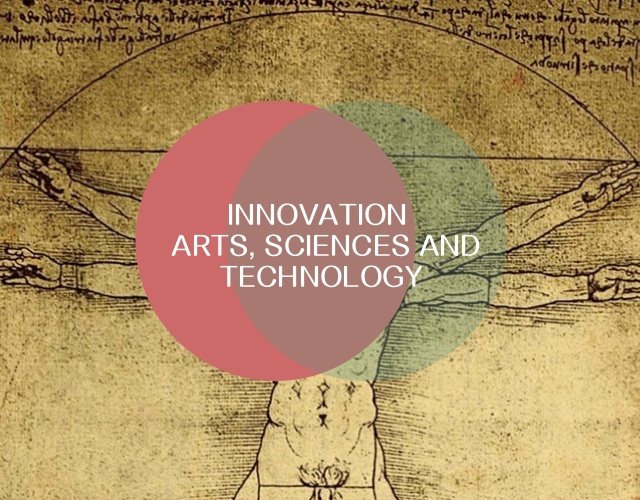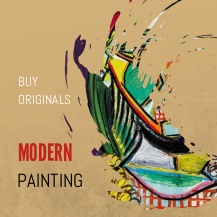- Innovation at the intersection of Arts, Sciences and Technology

- April 16, '20


by Virtosu Art Gallery
April 16, '20Innovation at the intersection of Arts, Sciences and Technology
For as long as humanity existed, innovation was the driving force that moved our world forward. We could say that technology started developing from the moment humans began creating and improving tools, building better shelters, and gathering into communities that would become the stepping stones for advancing into today's civilization.
In parallel, while we were learning how to make our living easier and our work more productive and effective, artistic expression was blossoming. From cave paintings to today's immersive exhibition shows, art has been and still is, among other things, a medium we use to ask questions about who we are, why we are here, and what being human essentially means.
Although we sometimes tend to observe art as a notion opposed to science and technology, they have always been inevitably intertwined. These aspects of human creative force advanced separately, and yet, there were still moments in time when they would touch and influence each other, changing the status quo.
From deductive to intuitive, and vice versaThe means of artistic expression changed from century to century, and technological advancements played an essential role in the process. The invention of the printing press affected the way we read and write, the introduction of photography (and then its switch from analog to digital) transformed the way we capture the beauty of the world, while the creation of devices able to store, play, and alter sound changed the way we compose and enjoy music forever.
At the same time, just as science and the unstoppable advancement of technological tools and gadgets transformed art, the different influence was also taking place. The artist who embodies this correlation best is undoubtedly Leonardo da Vinci, the Renaissance painter, sculptor, and inventor who spent his life elevating his art with technology and inspiring his scientific endeavors with his creative genius.
However, the 21st century is quickly shaping to become the time when the correlation between art, science, and technology will start looking nothing short of mindblowing. The world we live in is, once again, going through a revolution of a sort, showing how magical and inspiring the cooperation between deductive and intuitive can be.
Contemporary art meets science and technologyThere were many notable art pieces and exhibitions in the last decades that marked the beginning of a new era. Here are a few grand experiments in the art + science department that absolutely shouldn't be missed.
Machines and Souls exhibitionThis astonishing exhibition, which features works from several esteemed artists (including David Byrne from the legendary Talking Heads), philosophically explores the complicated relationship between humans and machines through robotics, software art, information visualization, and other technological tools.
Eric Standley's laser-cut paper masterpiecesEric Standley is a figure that genuinely impresses: He's an Associate Professor of Studio Art and Foundations of Art and Design Coordinator for the School of Visual Arts at Virginia Tech who creates incredibly complex paper works of art precisely cut into filigree shapes using the latest laser technology.
Magic Lining exhibitionThe Magic Lining project (explained by the artist Kristi Kuusk as "an exploration of smart textiles altering people's self-perception") was done in collaboration between the artist and a team of scientists (called MAGIC SHOES) active in spheres such as human-computer interaction, psychology, and neuroscience. This surely is an exhibition that would leave no one indifferent.
Jacob Collier is a young composer and multi-instrumentalist known for his impressive knowledge of music theory and the unique atmosphere he evokes with his music. His sound is the result of neverending exploring and experimenting, and the special harmonizer created for him by Ben Bloomberg, a creative technologist, specialized in advanced surround sound and interactive music systems.
Future Fires / LuminaryFeaturing the installation team called Nature / Unnature, the Dream Logic artist collective explores the correlation between these two concepts, further explaining this exhibition by asking the question: "May we experience epiphanies and cathartic experiences in our "natural" minds, spurred by "unnatural" creations in VR?"
ConclusionLooking from a somewhat philosophical perspective, the work of an artist and a scientist have a lot in common. They both use their creativity and imagination to help elevate human existence: An artist by expressing their vision of the world, and a scientist by working to explain theirs.
Technology, on the other hand, is a tool they both use in the attempt to make us understand our place in the universe and create a world that is an excellent place to be. As technology progresses and the artistic visions transform, we can expect even greater things to happen in the future. "Could we be looking into an era when even robots will be able to paint, create music, or write my paper?", you may ask. The way things are shaping up to be, we just might.

-
Art Advisory Services



